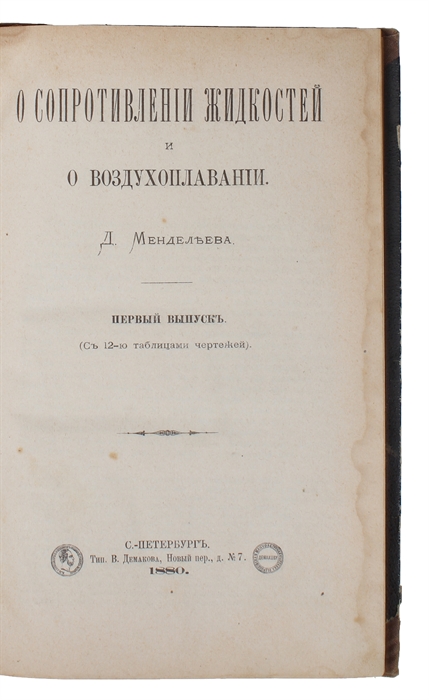THE BASIS OF RUSSIAN AERONAUTICS
MENDELEEV, D.
O soprotivlenij schidkostey i o vuzduchoplavani. [On the Resistance of Liquids and Air flying/ About Liquids Resistance and Aeronautics].
S.-Peterburg, 1880. 8vo. Contemporary half calf. Capitals and corners with wear. Some crayon-underlinings and some brownspotting. (2),160; 80 pp + 12 folded plates.
Scarce first edition of this fundamental guide of aeronautics, which constitutes one of the most important works in aviation history. The work formed the basis for Russian aeronautics, influencing the likes of Tsiolkovsky.
The great Russian chemist D.I. Mendeleev suspected that, in the highest levels of the Earth atmosphere, the Ether might exist at natural vacuum. It is this thought that sparks his growing interest in meteorology and aeronautics, which begins to take form in the 1870'ies. For Mendeleev aerodynamics and aeromechanics was inseparably linked to hydrodynamics and hydromechanics, and also to the theory of shipbuilding. He viewed these as belonging to one general problem, which he called media resistance and which he summarized and described in detail in his important work "On the Resistance of Liquids and Air flying"/" About Liquids Resistance and Aeronautics", 1880 [i.e. the present work].
A great part of the work is dedicated to the questions of hydrodynamic theory and contains important analyses of the development of liquids resistance theory from Newton till Froud. Pinpointing the weakest points of the hitherto most important theories, he concluded that even the most important scientists were not able to understand the not examined resistance and thus that theoretical studies alone will not be able to resolve the issue, but require conjoint regular tests of models in hydrodynamic laboratories.
Thus, Mendeleev initiated a new school, namely that of experimental hydrodynamics of ships, and the present work became one of the fundamental guides for work in shipbuilding, aeronautics, airplane construction, and ballistics. It greatly influenced the likes of Tsiolkovsky and Zhukovsky and thus formed the basis of Russian aeronautics.
It is in the present work that Mendeleev first describes his famous aerostat, the first attempt by Russian. His aerostat was supposed to be able to reach the stratosphere, but the project was never realized. His interest in aerostatics, however, as presented in the present work, led to his famous baloon ride in 1887, to watch the full solar eclipse.
"The earliest attempts to establish the theoretical possibility of air flight were made by Leonardo da Vinci, whose observations of bird flight inspired him to conceive the ideas of flying on heavier-than-air machines, of the helicopter, and of the parachute. But credit for the further development of his theoretical ideas and their realization belongs to the Russians... A large contribution to the development of aviation was made by D.I. Mendeleev, who conceived of a stratospheric balloon and devised plans for its construction in 1875. The first foreigner to construct a stratospheric balloon was Picard in 1931. In 1887, Mendeleev ascended 3,350 meters in the balloon to observe a solar eclipse. Mendeleev defined the future significance of aviation with great foresight. His "On the Resistance of Liquids and Aeronautics" (1880) served as one of the fundamental guides for work in shipbuilding, aeronautics, airplane construction, and ballistics." (Geldern & Stites edt.: Mass Culture in Soviet Russia, p. 480).
Order-nr.: 49439


![O soprotivlenij schidkostey i o vuzduchoplavani. [On the Resistance of Liquids and Air flying/ About Liquids Resistance and Aeronautics].](/images/product/49439b.jpg)